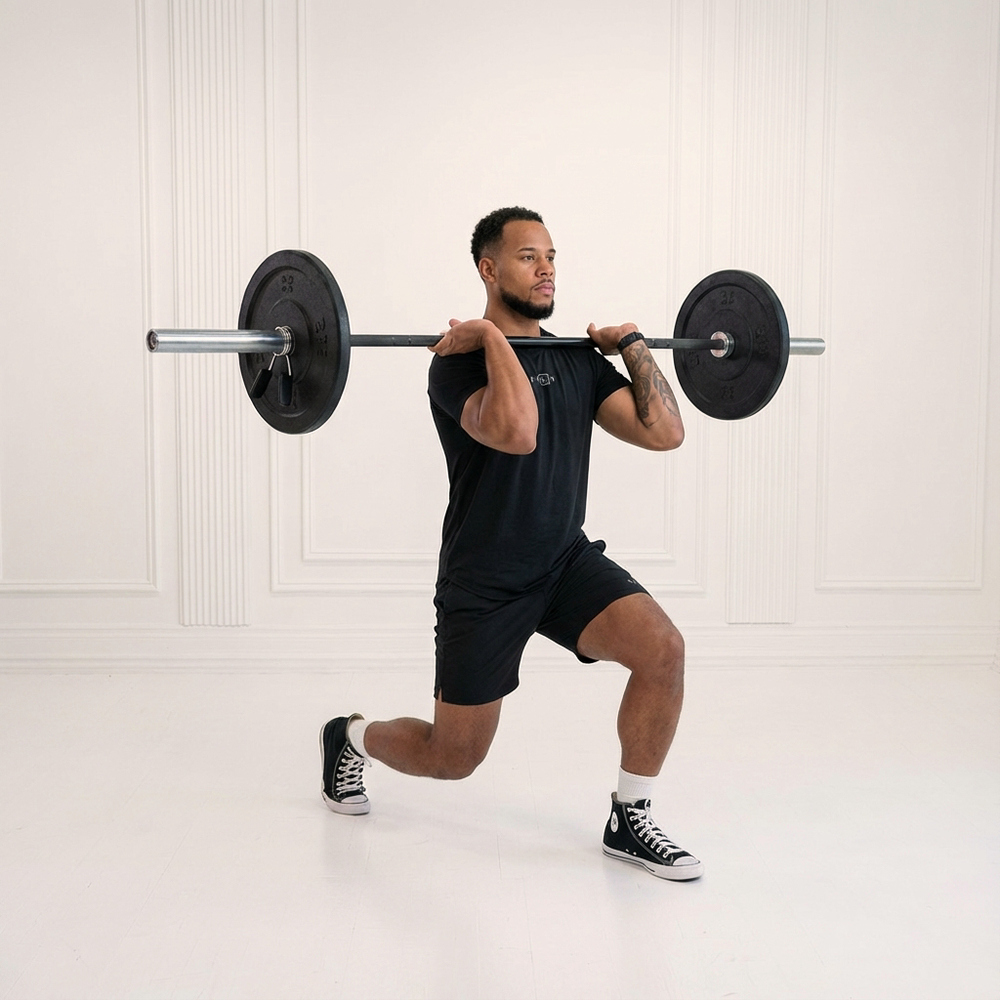Barbell Front Squat
 Auto Detected
Auto DetectedA barbell squat variation with the bar racked on the front shoulders, targeting quads, glutes, and core for lower body strength, power, and improved mobility; emphasizes upright torso and requires wrist flexibility.
About Exercise
Equipment
Barbell, Squat Rack
Difficulty
4/5 • Intermediate
Primary Muscle Groups
Quads, Glutes
Secondary Muscles
Hamstrings, Traps, Shoulders, Obliques, Calves
Popularity Score
8
Goals
Training Style
Setup Requirements
Requires Rack
Yes
Requires Bench
No
Requires Spotter
No
Space Needed
Medium
Noise Level
Moderate
Muscle Breakdown
View Muscle MapQuads
9/10Rectus Femoris, Vastus Lateralis, Vastus Medialis
Glutes
8/10Glute Max
Abs
7/10Rectus Abdominis, Transverse Abdominis
Lower Back
6/10Erector Spinae
Hamstrings
5/10Biceps Femoris, Semitendinosus
Traps
4/10Upper Traps
Shoulders
4/10Anterior Delts
Obliques
4/10External Obliques
Calves
3/10Gastrocnemius
Programming
Typical Rep Range
4-12 reps
Rest Between Sets
120-180 seconds • Longer for heavy sets
How to Perform
Set the barbell in a squat rack at clavicle height with safety bars at squat depth. Position the bar on your front shoulders in a clean grip with elbows high, feet shoulder-width apart.
- Brace core and unrack the bar by standing tall, then step back.
- Inhale and sit back and down, keeping torso upright and elbows high.
- Lower until thighs are parallel to the floor or deeper, knees tracking over toes.
- Pause briefly at the bottom without bouncing.
- Drive through heels to extend hips and knees explosively.
- Exhale as you reach full extension, maintaining upright posture.
- Step forward to rerack the bar securely.
Coaching Tips
Form Cues
- Elbows up high
- Torso upright
- Drive through heels
- Knees over toes
- Core braced tight
- Chest proud
Breathing
Inhale deeply to brace core before descending, exhale forcefully during ascent.
Tempo
3-1-1
Range of Motion
Descend from full hip and knee extension to thighs parallel to floor or hamstrings near calves, with torso remaining upright.
Safety
Safety Notes
- Use safety bars to catch failed reps
- Start with light weight to master form
- Avoid if wrist or shoulder mobility is limited
- Maintain neutral spine to protect lower back
- Ensure rack height prevents tiptoe unracking
- Do not use cross-arm grip for heavy loads
Spotting
Spotting not typically needed in a rack with safeties; if free bar, assist from behind with hands under bar for heavy sets.
Common Mistakes
- Elbows dropping forward
- Rounding upper back
- Knees caving inward
- Bouncing at bottom
- Leaning too far forward
- Poor wrist position
When to Avoid
- Acute shoulder impingement
- Wrist injuries
- Lower back pain
- Knee instability
Flexibility Needed
- Wrist flexion for clean grip
- Shoulder flexion to 140 degrees
- Ankle dorsiflexion for depth
Build Up First
- Mastery of bodyweight squat
- Core bracing proficiency
- Familiarity with back squat
Also known as
Front Squat, Olympic Front Squat, Clean Grip Squat
Found this helpful?
Share your thoughts or help us improve this guide.
Similar Exercises

Barbell Power Clean to Front Squat
Barbell, Plates
Quads

Barbell Front Rack Lunge
Barbell
Quads

Barbell Back Squat

Barbell, Squat Rack
Quads

Barbell Sumo Squat
Barbell, Squat Rack
Glutes

Barbell Split Squat

Barbell, Squat Rack
Quads

Barbell Squat Press
Barbell, Squat Rack
Quads

Barbell Back Box Squat
Barbell, Squat Rack
Glutes

Barbell Zercher Squat
Barbell, Squat Rack
Quads

Barbell Zercher Squat
Barbell, Squat Rack
Quads

Barbell Pulse Back Squat
Barbell, Squat Rack
Quads


subscribe to our newsletter
Contact Us
hello@trainfitness.aiFind Us
130 Spadina Avenue, Toronto,
Ontario, M5V 0H4, Canada
©2025 All Rights Reserved
